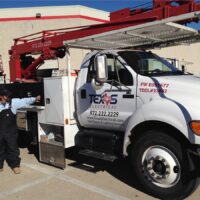Improving workplace safety culture requires consistent leadership engagement and comprehensive employee training. Establishing clear safety protocols and encouraging open communication are essential steps.
In any job environment, a strong safety culture is paramount to the wellbeing of staff and the overall operational efficiency. A workplace where safety is prioritized not only minimizes injuries but also enhances productivity and employee morale. To foster a robust safety culture, businesses must implement targeted strategies that resonate with everyone from management to the front-line workers.

Empowering employees with the knowledge of best safety practices and recognizing those who exemplify these standards can lead to a proactive approach to preventing accidents. Communication channels should also be streamlined to facilitate easy reporting and discussion of safety concerns. By embedding safety into the core values of the company, employers can create a space where workers feel secure and valued, which in turn contributes to a more dedicated workforce and a healthier work environment.
The Foundation Of Safety Culture
Safety culture stands as the cornerstone of a thriving workplace. It is the foundation upon which all employee well-being initiatives rest. Setting the right tone for a culture of safety impacts every organizational level. Let’s explore the essential bricks that lay the groundwork for this vital structure within the business environment.
The Concept Of Safety Culture
Safety culture embodies the collective commitment of a company to prioritize and enhance safety measures. Organizations with a strong safety culture value all aspects of safety, from rules to attitudes. These are the elements that empower employees to not only follow safety protocols but also promote safe practices proactively.
- Employee Participation: Workers at every tier actively engage in crafting and abiding by safety policies.
- Management Commitment: Leaders demonstrate safety importance through actions and communications.
- Regular Training: Continuous education maintains a high level of safety awareness and skill.
- Transparent Communication: Open channels enable reports on hazards without fear of retribution.
The Importance Of A Strong Safety Foundation
A strong safety foundation is crucial for a flourishing organization. It serves as the bedrock that holds the structure of a company’s welfare intact. With a robust foundation, the overall productivity and morale soar as employees feel secure and valued.
| Element | Impact |
|---|---|
| Leadership Example | Sets a safety-first mindset |
| Policies & Procedures | Give clear safety directions |
| Employee Engagement | Drives safety as a shared value |
| Continuous Improvement | Adapts and grows safety measures |
Assessing Your Current Safety Culture
An effective safety culture is a cornerstone of a productive workplace. Before embarking on any improvement plan, an assessment of your current safety culture is essential. This crucial step identifies the strengths and gaps, forming a baseline for strategy development.
Tools And Methods For Assessment
To gauge your current safety standing, a variety of tools and methods are at your disposal:
- Surveys and questionnaires provide direct insights from employees.
- Safety audits evaluate compliance with regulations.
- Incident reports highlight recurring issues and trends.
- Focus groups encourage open discussion on safety topics.
- Observation walkthroughs reveal real-time practices at work.
Combining these tools delivers a comprehensive overview of your safety culture.
Interpreting Assessment Outcomes
Understanding assessment data is key to making informed decisions:
- Identify patterns and trends from collected data.
- Consider feedback to spot areas for enhancement.
- Compare findings with best practices and benchmarks in your industry.
- Prioritize action items based on risk and impact.
Bold steps toward a positive safety culture begin with a thorough understanding of where you currently stand.
Elements Of An Effective Safety Culture
An effective safety culture at any workplace is the backbone of operational excellence. It ensures not only the physical well-being of the team but also fosters a supportive and engaged work environment. The core elements of such a culture hinge on strong leadership, clear communication, and proactive participation by every team member.
Commitment From Management
Driving a safety-first mindset starts at the top. The commitment of senior leaders is essential. They must set clear safety goals and provide the necessary resources. Visible leadership involvement inspires confidence and commitment among employees.
Key actions include:
- Setting clear safety objectives aligned with business goals
- Regularly communicating the importance of safety
- Ensuring adequate training and development programs
- Leading by example, showcasing the behavior they expect from others
Employee Involvement And Empowerment
Employees’ voices are crucial for a robust safety culture. When employees are involved, they feel valued and take ownership of their safety and the safety of colleagues.
An empowered workforce can:
- Identify and report potential hazards without fear
- Participate in safety committees or meetings
- Take part in training to reduce risks
- Suggest improvements to safety protocols and procedures
Education And Training For Safety
Creating a robust safety culture at the workplace begins with proper education and training. Empowering employees with knowledge and skills not only reduces accidents but also boosts their confidence. Tailored training programs help to understand safety protocols and procedures effectively. More than just compliance, it’s about building an environment where safety comes first.
Continual Learning Opportunities
Safety education should never stop. It’s a journey, not a destination. Keeping up to date with the latest safety practices keeps the workplace safe.
- Regular workshops and seminars on new safety techniques.
- Online courses available for learning at one’s own pace.
- Safety drills that prepare for real-life emergencies.
- Refreshers on safety protocols to keep information fresh.
Scenario-based Training Practices
Learning through experience is powerful. Scenario-based training immerses employees in real-life situations.
- Mock drills that simulate actual emergencies.
- Table-top exercises where teams solve problems together.
- Role-playing different accident scenarios to build response skills.
- Interactive games that teach safety in a fun way.
Communication As A Safety Enhancer
A strong safety culture thrives on effective communication. Clear and consistent exchanges between everyone, from management to new recruits, form the backbone of a safe workplace. By talking openly about safety expectations and concerns, a company ensures that employees feel heard and valued. This leads to proactive safety management where every individual contributes to a healthier and more secure work environment.
Open Channels For Feedback
Ensuring open communication lines where employees can report hazards or voice safety suggestions is crucial. Transparency in feedback mechanisms encourages a participatory approach to workplace safety.
- Anonymous Surveys: Allow employees to share concerns without fear of repercussion.
- Suggestion Boxes: Place them in accessible areas to collect safety improvement ideas.
- Digital Platforms: Utilize internal networks for quick and effective communication.
Regular Safety Meetings
Meetings focused on safety keep the conversation going and ensure that all team members are up to date with recent safety protocols and practices. Regular intervals foster a habit of safety-first thinking.
| Meeting Type | Purpose | Frequency |
|---|---|---|
| Team Briefings | Discuss daily safety tasks. | Daily/Weekly |
| Training Sessions | Build safety skills. | Quarterly |
| Review Meetings | Evaluate safety procedures. | Bi-annually |
Harnessing Technology For Safety Improvements
Workers’ safety is at the center of a thriving business. Technology plays a key role in developing this safe space. It offers smart solutions to protect staff. Let’s dive into how tech boosts safety at work.
Innovative Safety Tools
New safety tools change how we protect staff. Wearables can track health on the go. Augmented reality can train teams without risk. These tech tools help prevent accidents.
- Wearables – Monitors like Fitbit ensure employees’ health is not at risk.
- Smart Helmets – They can show vital safety info in real time.
- Apps – Software on phones help report risks instantly.
The Role Of Data Analytics
Big data is a game-changer in keeping workplaces safe. Data analytics helps us see patterns we might miss. It suggests actions to stop accidents before they happen.
| Tool | Use |
|---|---|
| Data Reports | Shows safety trends over time. |
| Real-Time Alerts | Sends warnings to prevent harm. |
| Predictive Modeling | Forecasts potential risks. |
Recognition And Reward Systems
Creating a strong safety culture at work is crucial. It saves lives and enhances overall productivity. Recognition and Reward Systems play a pivotal role in this. Such systems encourage employees to follow safety protocols. They make employees feel valued for their efforts in maintaining a safe workplace.
Positive Reinforcement Strategies
Positive reinforcement shapes behavior by rewarding good practices. Well-designed strategies boost morale. They encourage ongoing commitment to safety. Recognize behaviors that contribute to a safer environment promptly and consistently. Use:
- Bonus programs for teams with the best safety records.
- Public recognition in meetings for individuals who identify hazards.
- Personal thank-you notes from management to reinforce positive actions.
Safety Milestones And Acknowledgments
Marking safety milestones is another key to improving workplace safety culture. Acknowledge the dedication it takes to reach these milestones. Celebrate them with the entire team. Some ideas for acknowledgments include:
| Milestone | Reward |
|---|---|
| 100 Days Accident-Free | Team lunch or dinner |
| 1 Year Injury-Free | Bonus or gift cards |
| Excellent Safety Audit | Extra vacation day |
These milestones offer tangible goals. They keep the focus on safety every day. Celebrate them to show your team that their health and safety are the top priorities.
Audit And Review Strategies
Workplaces thrive when a strong safety culture is in place. One way to ensure this involves implementing robust Audit and Review Strategies. Regular assessments and reviews of safety procedures help identify potential hazards, ensuring the well-being of all employees.
Scheduled Safety Audits
Scheduled Safety Audits are essential for a proactive safety approach. Businesses need to plan routine checks to maintain high safety standards.
- Set Frequency: Decide on how often to conduct safety audits—monthly, quarterly, or yearly.
- Checklist Creation: Develop a comprehensive list to assess all aspects of workplace safety.
- Involve Employees: Engage staff to participate in audits for diverse insights.
- Action Plan: Create clear steps to address any identified issues.
Learning From Safety Incidents
Reviewing past incidents plays a critical role in preventing future accidents.
- Record and analyze every incident, no matter how small.
- Share findings with the entire workforce for transparency.
- Update training programs to include new preventive measures.
Implement changes swiftly to demonstrate a commitment to safety.
Challenges And Solutions In Enhancing Safety Culture
Building a robust safety culture in the workplace is crucial. It helps prevent accidents and ensures employee well-being. But enhancing safety culture faces hurdles. Addressing these effectively improves safety for everyone. Let’s explore challenges and solutions.
Addressing Resistance To Change
Change often meets resistance. Workers may cling to the “old ways” of doing things. Leaders struggle to motivate their teams towards new safety practices. This resistance is a major roadblock. Let’s dive into how we can overcome it.
- Communication: Start with clear, continuous dialogue about safety’s value.
- Training: Provide comprehensive training that demonstrates safety’s practical benefits.
- Incentives: Encourage adaptation by rewarding those who embrace changes.
Long-term Culture Adoption Hurdles
Establishing a safety-first mindset is a marathon, not a sprint. The goal is to make safety an integral part of every job, not just a set of rules to follow. Long-term adoption can be complex. Here are steps to make it smoother.
- Leadership Involvement: Leaders must show sustained commitment to safety.
- Continuous Improvement: Regularly assess and adapt safety protocols for effectiveness.
- Employee Empowerment: Equipping employees with decision-making authority promotes ownership of safety practices.
A Global Perspective On Safety Culture
A deep dive into the concept of safety culture reveals a mosaic of practices and beliefs that span across the globe. Recognizing that safety has no borders, businesses are now looking beyond their local practices and learning from the rich tapestry of international experiences. A strong safety culture is a catalyst for not only preventing accidents but also for bolstering the global economy through responsible management of workforce welfare.
International Standards And Regulations
Safety standards serve as the foundation for protecting workers worldwide. These benchmarks promote a cohesive approach to prevent workplace hazards. Organizations like the International Labour Organization (ILO) and the International Organization for Standardization (ISO) provide frameworks such as ISO 45001, guiding companies towards excellence in occupational health and safety.
- ISO 45001: A Global Framework for Occupational Health and Safety Management.
- ILO Guidelines: Comprehensive safety and health protocols, adaptable by any country.
Case Studies From Around The World
Exploring case studies from different nations paints a clear picture of diverse safety cultures. These narratives highlight successful strategies and pivotal learning moments for organizations seeking excellence in safety culture.
| Country | Industry | Key Takeaway |
|---|---|---|
| Japan | Manufacturing | Kaizen philosophy for continuous safety improvement. |
| New Zealand | Construction | Collaborative safety programs reducing workplace incidents. |
| Brazil | Agriculture | Community-led initiatives promoting safety education. |
Each study showcases bespoke initiatives and adaptations to local contexts, demonstrating global safety culture’s versatile nature. Companies worldwide can draw from these stories to enhance their safety infrastructure and protect their workforce.
The Road Ahead: Continuous Improvement In Safety
The Road Ahead: Continuous Improvement in Safety marks a commitment to never stand still in the realm of workplace safety. It is a journey that demands perpetual vigilance and innovation, and prioritizes the well-being of employees above all. This relentless march towards a safer workplace involves harnessing new technologies, updating procedures, and fostering a safety-first mindset across all levels of an organization.
Innovations In Workplace Safety
Innovative technologies change the landscape of workplace safety. Companies now have access to cutting-edge tools that can dramatically reduce the risk of injury and improve response times during emergencies.
- Wearable devices that monitor vital signs
- Automated safety sensors that detect hazards
- Machine learning algorithms that predict potential incidents
Safety training also benefits from innovation, with virtual reality simulations offering realistic training scenarios without the risks associated with physical training.
The Ever-evolving Safety Landscape
The nature of workplace safety is dynamic, reflecting ongoing changes in regulations, industry standards, and employee expectations. Organizations must stay updated with these changes and apply them to their safety protocols to maintain a high standard of safety culture.
- Regularly update safety policies in line with changing laws.
- Engage with safety professionals to stay ahead of industry trends.
- Encourage employee feedback to refine safety measures.
Continuous education and training programs are fundamental to keep everyone informed about the latest safety guidelines and practices.
Frequently Asked Questions For Safety Culture At Workplace How To Improve
What Is A Safety Culture In The Workplace?
A safety culture in the workplace refers to the shared beliefs, practices, and attitudes within an organization that prioritize safety. It involves everyone’s commitment – from executives to frontline workers – to maintain and improve a safe working environment.
How Can Employers Improve Workplace Safety?
Employers can improve workplace safety by providing regular training, ensuring proper use of gear, and encouraging clear communication. Additionally, implementing a reporting system for hazards plays a key role in proactive risk management.
What Role Do Employees Play In Safety Culture?
Employees are central to safety culture as they are often the first to notice hazards. Their involvement in safety programs, adherence to protocols, and willingness to report risks contribute significantly to maintaining a safe workplace.
Why Is A Strong Safety Culture Important?
A strong safety culture helps prevent workplace accidents, reduces costs associated with injuries, and enhances overall employee well-being. It fosters an environment where safety is ingrained in the fabric of daily operations.
Conclusion
Creating a robust safety culture is essential for the well-being of employees. It requires dedication, ongoing training, and clear communication. Start small, engage everyone, and remember: a safe workplace is a productive one. Let’s commit to continual improvement for the safety of all.
Together, we make work a safer space.




